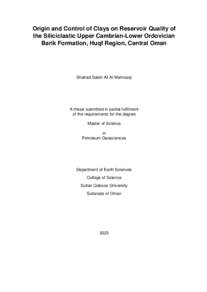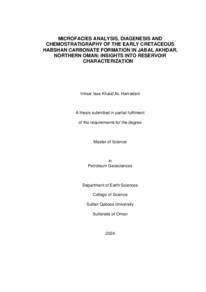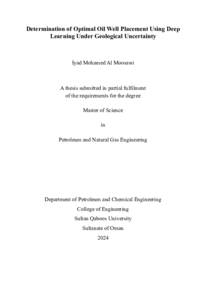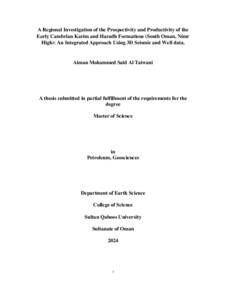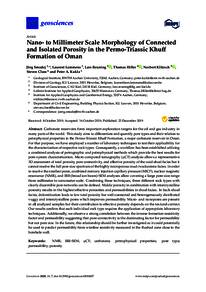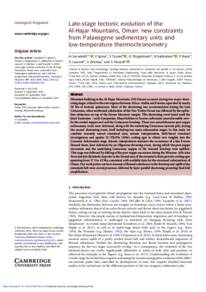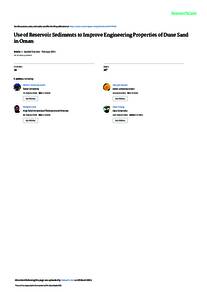وثيقة
Origin and control of clays on reservoir quality of the siliciclastic upper cambrian-lower ordovician Barik formation, Huqf Region, Central Oman.
عناوين أخرى
أصل وتحكم الطين على جودة الخزان لتكوين باريك العلوي الكمبري -الأوردوفيشي السفلي في منطقة حقف بوسط عمان
الناشر
Sultan Qaboos University.
ميلادي
2023
اللغة
الأنجليزية
الموضوع
الملخص الإنجليزي
Clays are important in several geological and environmental processes, as well as
in many human activities. They are a complex phyllosilicate group of minerals that
are most often intergrown, consist of a wide variety of solid solutions, and form
through different processes. The analysis of clay minerals was investigated for
diagenesis and reservoir quality prediction, as well as environmental
determination, stratigraphic correlation, and hydrocarbon production. The process
of clay neoformation and transformation in buried sediments is known as clay
diagenesis, which is affected by several factors such as detrital sediment
composition, depositional environment, temperature, and burial history. Grain coating clays, amongst other types of clays, are a common observed diagenetic
alteration in the studied Barik Formation. Clay coatings have a significant impact
on reservoir quality and petrophysical properties in sandstone reservoirs across
the world.
The Upper Cambrian-Lower Ordovician Barik Formation is a considerable deep
tight-gas reservoir in Central Oman. It is part of the Mahatta Humaid area in the
Huqf-Haushi region, Central Oman. The Barik Formation represents a series of
regressive-transgressive braid delta systems with influences from a marine setting.
The outcrop-equivalents in Central Oman are a good example for studying and
understanding how the grain clay coating is formed, as well as their distribution
and control on the Barik reservoir quality.
Scanning Electron Microscope (SEM) equipped with a Dispersed Energy
Spectrometer (EDS), X-Ray Diffraction (XRD), X-Ray Fluorescence (XRF), and
Quantitative Electron Microscopy Scanning (QEMScan) was performed on the
representative collection of samples to determine the petrographical,
mineralogical, and geochemical examinations. Petrog Software was used to
measure the coverage and thickness of grain coating clays on a few samples.
There are four major types of clay minerals present in Barik sandstone. Barik
sandstone was observed to undergo several diagenetic alteration processes, such
as mechanical compaction, dissolution and kaolinization, clay coating grains, and
cementation by quartz and feldspar overgrowths. Diagenetic grain-coating clays
are mainly composed of chlorite and illite. Illite and chlorite are partially and
completely coating the sand grains. The average coat coverage in the
representative samples exceeds 30%, and the average thickness of clay coatings
varies from 1.7 μm to 9 μm. The chlorite and illite grain coatings are more abundant
within the mouth bar/shoreface and tidal channels, while being less common in the
tidal flat and delta distributary channels. Illite and chlorite are suggested to have
formed from smectite clay precursors infiltrated mechanically by tidal
hydrodynamic pumps. Thick and continuous diagenetic chlorite and illite grain
coatings inhibit the nucleation sites for quartz and feldspar overgrowth
cementation, thus preserving the reservoir porosity.
المجموعة
URL المصدر
الملخص العربي
الطين مهم في العديد من العمليات الجيولوجية والبيئية، وكذلك في العديد من الأنشطة البشرية. وهو عبارة عن مجموعة معقدة من الفلوسيليكات من المعادن التي غالبًا ما تكون متداخلة، وتتكون من مجموعة متنوعة من المحاليل الصلبة ، وتتشكل من خلال عمليات مختلفة. تم دراسة تحليل معادن الطين من أجل التحورات والتنبؤ بجودة الخزان، وكذلك التحديد البيئي، والارتباط الطبقي، وإنتاج الهيدروكربون. تُعرف عملية التشكيل الجديد للطين والتحول في الرواسب المدفونة باسم تحلل الطين، والذي يتأثر بعدة عوامل مثل تكوين الرواسب ، والبيئة الترسيبية ، ودرجة الحرارة ، وتاريخ الدفن. غلاف الطين حول الحبيبات، من بين أنواع أخرى من الط ين هو أكثر التحورات شيوعًا التي لوحظت في تكوين الباريك المدروس. للغلاف الطيني تأثير كبير على جودة الخزان والخصائص البتروفيزيائية في خزانات الحجر الرملي في جميع أنحاء العالم. يعتبر تكوين باريك العلوي الكمبري - األوردوفيشي السفلي خزانًا كبي ًرا عميقًا للغاز المحكم في وسط عمان. هو جزء من منطقة محطة حميد في منطقة حقف حاشي بوسط عمان. يمثل تكوين باريك سلسلة من أنظمة دلتا الجديلة الارتدادية في وسط عمان مثالا غلاف المتجاوزة بتأثيرات من بيئة بحرية. تعتبر التكشفات المكافئة جيدًا لدراسة وفهم كيفية تشكل الطين حول الحبيبات ، وكذلك توزيعها والتحكم في جودة خزان باريك. تم إجراء مسح المجهر الإلكتروني المجهز بمطياف الطاقة المشتت، وانحراف الأشعة السينية، و فلورية الأشعة السينية، والمسح المجهري الإلكتروني الكمي على المجموعة التمثيلية للعينات لتحديد الفحوصات البتروغرافية والمعدنية والجيوكيميائية. تم استخدام برنامج بتروج لقياس تغطية وسماكة غلاف الطين حول الحبيبات في عينات قليلة. هناك أربعة أنواع رئيسية من معادن الطين الموجودة في الخزان الرملي باريك. لوحظ أن الحجر الرملي باريك يخضع لعدة عمليات تغيير، مثل الضغط الميكانيكي، والذوبان والكاولين، وغلاف الطين حول الحبيبات، والتدعيم عن طريق نمو الكوارتز والفلسبار الزائد. يتكون غلاف الطين المتحور حول الحبيبات بشكل أساسي من الكلوريت والايلايت. يقوم الإيلايت والكلوريت بتغطية حبيبات الرمل جزئيًا وكامًال. يتجاوز متوسط تغطية الغلاف في العينات التمثيلية ،٪30 ويتراوح متوسط سماكة الغلاف الطيني من 1.7 ميكرومتر إلى 9 ميكرومتر. تكون غلافات حبيبات الكلوريت والإيلايت أكثر وفرة داخل شريط الفم / واجهة الشاطئ وقنوات المد والجزر، بينما تكون أقل شيوعًا في قنوات المد والجزر المسطحة وقنوات الدلتا التوزيعية. يُقترح أن يكون الإيلايت والكلوريت قد تشكال من سالئف طين السميكتايت التي تم تخللها ميكانيكيًا بواسطة عمليات المد والجزر الهيدروديناميكية. يعمل غلاف الكلوريت والايلايت السميك والمستمرعلى تثبيط مواقع التنوي لتدعيم نمو الكوارتز والفلدسبار الزائد، وبالتالي الحفاظ على مسامية الخزان.
قالب العنصر
الرسائل والأطروحات الجامعية

